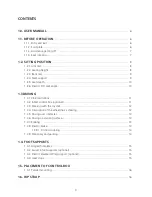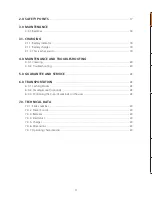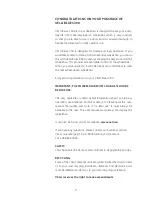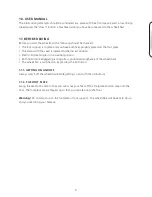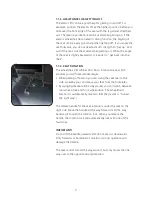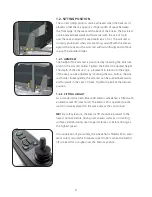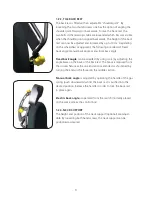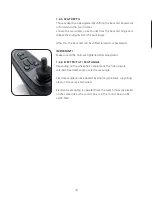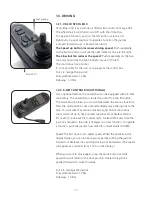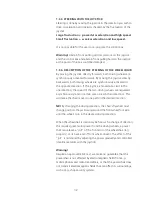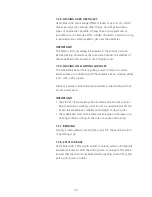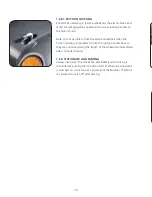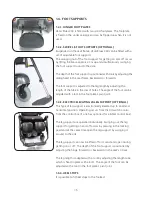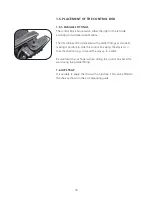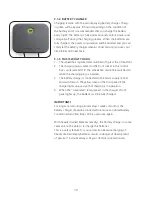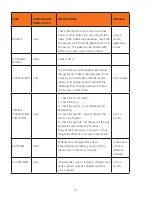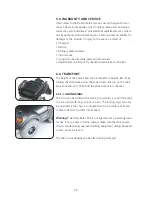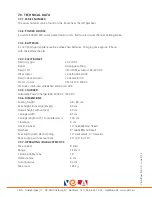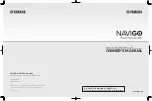
1.3.3. STEERING WITH THE JOYSTICK
Steering is done by moving the joystick in the direction you wish to
drive. Acceleration and speed is checked by the fluctuation of the
joystick:
Large fluctuation = powerful acceleration and high speed.
Small fluctuation = weak acceleration and low speed.
It is not possible for the user to re-program the control box.
Warning!
Abstain from putting vertical pressure on the joystick
and the control box and abstain from pulling hard on the joystick
as the parts of the box could be damaged.
1.3.4. DESCRIPTION OF THE STEERING OF THE WHEELCHAIR
By moving the joystick directly forwards, both driving wheels are
synchronously activated forwards. By moving the joystick directly
backwards, both driving wheels are synchronously activated in
the opposite direction. If the joystick is moved at a slant in the
one direction, the speed of the two driving wheels are regulated
asynchronously (and in certain cases in each their direction). This
will make the chair move in one path in the desired direction.
NB!
By changing the driving direction, the chair’s flywheel must
change position: they will swing around the front wheel fork axle
until the wheels turn in the desired driving direction.
When the wheelchair is stationary before such a change of direction,
this requires great motor power from the driving wheels, a power
that can release a “jolt” of the front end of the wheelchair (leg
supports) or its back end (if front wheel-driven). The effect of this
“jolt” is minimised by adjusting the power gradually and controlled
(small movements with the joystick).
Warning!
Despite an approved EMC test, we make no guarantee that the
powerchair is not affected by electromagnetic fields from e.g.
mobile phones and radio transmitters, or that the powerchair does
not transmit electromagnetic fields that can affect its surroundings,
such as e.g. shop security systems.
1.3.5. DRIVING OVER OBSTACLES
VELA Blues 300 can manage different levels of up to 4 cm, which
makes passage over, among other things, doorsteps and many
types of approaches possible. Always drive as perpendicular as
possible on such obstacles. With sudden obstacles, a certain run-up
is required and a certain speed to get over the obstacles.
IMPORTANT!
The electric lift must always be lowered to the bottom position
before tackling obstacles as the raised seat impairs the stability of
the wheelchair and can lead to risk of tipping over.
1.3.6. DRIVING ON SLANTING SURFACES
The wheelchair has sufficient pulling power to drive up normal
existing ramps in connection with the residence (max. climbing ability
is 12° with a 75 kg load).
Descent is always carried out perpendicular to the slanting surface
and at a calm pace.
IMPORTANT!
•
The electric lift must always be lowered to the bottom position
before driving on slanting surfaces, since a raised electric lift can
impair the wheelchair’s stability with danger of tipping over.
•
The wheelchair must not be driven at an angle or sideways on a
slanting surface as tilting to the side can cause overturning.
1.3.7. BRAKING
Driving is interrupted by moving the joystick to the centre position
or by letting it go.
1.3.8. ELECTO-BRAKE
VELA Blues 300 is fitted with an electro-brake, which automatically
activates the second after the driving motor is stopped. This brake
ensures that the chair is fully blocked when getting on and off, when
parking on ramps or similar.
13
12



